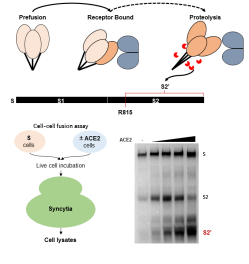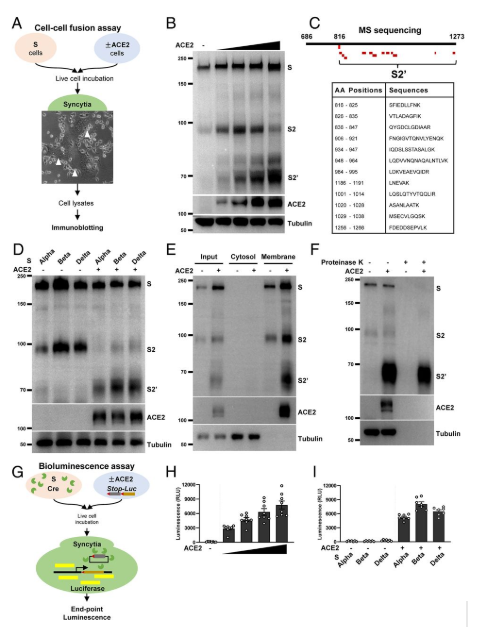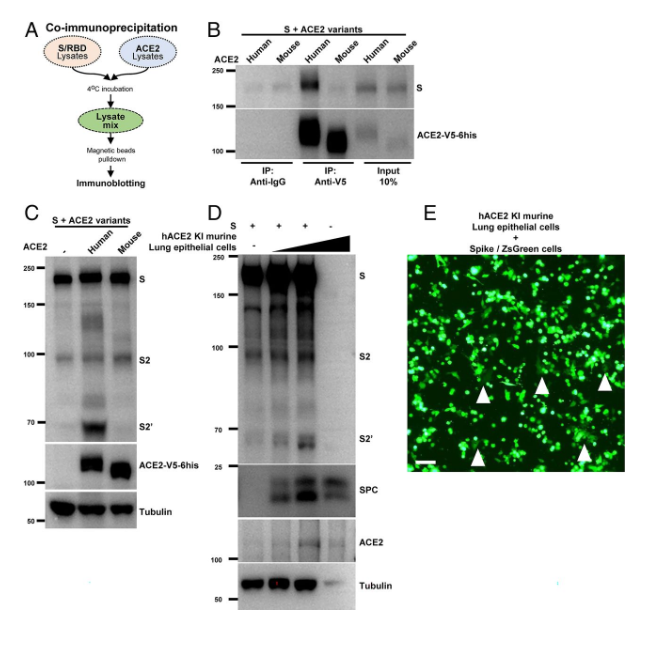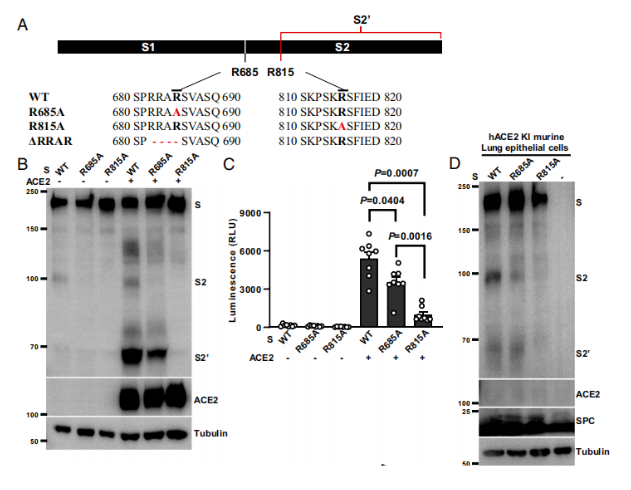

The COVID-19 pandemic caused by the novel coronavirus (SARS-CoV-2) infection has resulted in more than 330 million infections worldwide.The spike (S) protein of SARS-CoV-2 is responsible for host receptor recognition and the fusion of viral and cellular membranes, resulting in viral infection of host cells.
Currently,the prevalent mutant variants have multiple mutations in the spike protein, which brings challenges to updating the vaccine design.The S protein of SARS-CoV-2 contains two fragments: the S1 subunit and the S2 subunit. The S1 subunit located at the amino terminus contains a receptor binding domain (RBD) that recognizes and interacts with the host angiotensin-converting enzyme 2 (ACE2) receptor. The S2 subunit located at the carboxy terminus catalyzes the fusion of viral and cellular membranes,which promotes the release of viral RNA into the cell and initiates the biological process of viral replication in the infected cell. Research on viral infection mechanisms is the main focus of current pandemic containment and future prevention of coronavirus outbreaks. Although it has been found that the host ACE2 protein can bind to the viral spike protein, the molecular mechanism of binding remains unclear.
On December 21, 2021, a study was published in the comprehensive international academic journal "PNAS". This study, conducted through a cooperation including Guangxun Meng’s team and Dimitri Lavillette’s team from the University of Chinese Academy of Sciences,reveals the generation of SARS-CoV-2 S2′ fragments and the role of this fragment in recognition and membrane fusion between virus and receptor.

Technical Route
This study explores how the virus spike (S) protein can engage its receptor ACE2 in live cells.The researchers investigated the importance of the ACE2 protein for the infection process and the necessity of key amino acids on the spike for proteolysis,using cell-cell fusion techniques to analyze various cell lines and primary cells isolated from mice with humanized ACE2 (hACE2) knocked in.They found that ACE2 protein promotes the hydrolysis of viral spikes to generate the S2' fragment,a critical hydrolysis step that is important for spike-mediated membrane fusion.

Figure 1. In this study, the authors used an in vitro cell-cell fusion system. The S protein was expressed in different cells, and then co-cultured with cells with/without ACE2 receptor to detect the enzyme cleavage reaction,cell membrane fusion, and infection mechanism of the S protein during the fusion process [1].
To investigate the functional and biochemical characteristics of the spike (S) protein upon binding to its receptor ACE2 in living cells,the researchers used cell-cell fusion assays to obtain potentially cleaved spike protein products from syncytia.
Upon addition of HEK293T-ACE2 cells onto the spike-expressing HEK293T cells, the syncytia were lysed and researchers performed immunoprecipitation of spike protein products from HEK293T syncytia lysates. The results show that an additional band S2′ at∼68 kDa was detected, while control cells expressed only the spike protein and no S2' band was present. In addition,the brightness of the S2' band also depends on the number of ACE2-expressing cells added,suggesting that the increase in ACE2 promotes proteolytic processing of the spike protein.

Figure 2. Spike-driven syncytia formation is coupled to S2′ cleavage in the presence of ACE2 [1].
Previous studies have demonstrated that cells expressing mouse ACE2 are resistant to wild-type SARS-CoV-2 spike-mediated infection,so the researchers investigated whether the S2' fragments produced by human and murine ACE2 variants have the same effect.
To test this hypothesis, the researchers designed Co-immunoprecipitation (Co-IP) experiments to verify the differences of ACE2 proteins in different species.
The researchers found that the mouse ACE2 protein cannot bind to the RBD domain of the spike protein, while the human ACE2 protein can; not only that,but the human ACE2 protein can also interact with the full-length spike protein,while the mouse protein cannot.
In order to simulate the formation of spike-driven syncytia in primary cells,the researchers commissioned Cyagen to generate a human ACE2 gene knock-in mouse (H11 locus) model,and isolate the lung epithelial cells of the knock-in mouse.This strain of mice carries the "K18 promoter-Kozak-human ACE2 CDS-P2A-CreERT2-rBGpA" cassette,which expresses both human ACE2 receptors and CreERt2,which can be used to study specific host genes (floxed) in response to coronavirus infection role in induced tissues.The K18 promoter-driven hACE2-Cre-ERT2 knock-in (hACE2 KI) mice with a C57BL/6J background were generated by Cyagen and maintained for the described experiments. Not only that, the researchers detected the S2' band and observed the green fluorescent signal of syncytia formation.

Figure 3. S2′ generation requires specific recognition of functional ACE2 [1].
The SARS-CoV-2 spike protein can be cleaved at multiple locations,the most notable being the cross-strain conserved arginine residues at the S1/S2 junction (685) or S2′ site (815).To study its function, the researchers mutated the arginines at these two positions to alanines.
The experimental results showed that the spike containing the R815A mutation expressed by HEK293T cells resulted in the inability of the protein to hydrolyze S2',so the arginine at position 815 on the spike was necessary for the hydrolysis of S2'.

Figure 4. Spike arginine 815 is required for S2′ cleavage [1].
Summary
The above experiments prove that the hydrolysis of the spike protein to form the S2' protein is one of the indispensable molecular events in the process of coronavirus infection,and the arginine at position 815 is necessary for hydrolytic cleavage.
Cyagen's ACE2 Mouse Models: Empowering Coronavirus Scientific Research
Cyagen has used our proprietary TurboKnockout® technology and the optimized CRISPR-Pro technology to prepare three background strains of ACE2 mice:BALB/c, C57BL/6J, and C57BL/6N.Considering the advantages and disadvantages of different gene editing methods,a variety of gene targeting schemes and construction strategies have been designed to meet the needs of customers for different research purposes and different application directions.At the same time, we can provide the verification data report of the ACE2 mouse models for COVID-19 researchers.The newly-developed K18 promoter-driven hACE2-Cre-ERT2 knock-in (hACE2 KI) mouse model with a C57BL/6J background provides an additional platform for continued research.If you need a new coronavirus research related mouse model,please contact us or call 86 20-31601779 for consultation and order.
Reference:
[1] Shi Yu,Xu Zheng,Bingjie Zhou,Juan Li, Mengdan Chen,Rong Deng,Gary Wong, Dimitri Lavillette,Guangxun Meng,SARS-CoV-2 spike engagement of ACE2 primes S2’ site cleavage and fusion initiation.Proceedings of the National Academy of Sciences Jan 2022,119 (1) e2111199119;DOI:10.1073/pnas.2111199119
https://www.pnas.org/content/119/1/e2111199119




영업일 기준 1-2일 내에 답변해 드리겠습니다.